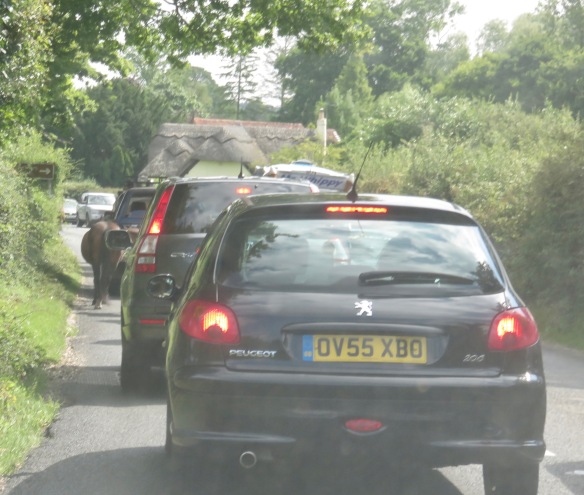Today was pleasantly temperate. We took an early drive into the forest where the wider roads are often crossed by hoofed animals who make the own tracks into the woodland.
We stopped at the junction between Crow Hill and Charles’s Lane for me to photograph examples.
The track forks with one tine running alongside Charles’s Lane
and the other crossing it to
continue beside Crow Hill.
Serendipitously, as I was making this record, a young equestrienne left the hill, crossed the lane,
and continued on down the slope. The horseshoe in this picture will be leaving its own print in the dusty soil;
the cloven , heart-shaped, depression in this will have been left by one of the string of cattle who are the real sappers of this terrain.
A couple of keen, fit, cyclists who stopped at this junction struggled to find a cycle track with the aid of their modern device. I offered them an example of old technology in the the form of an Ordnance Survey map. The woman said she preferred old technology, perused and returned it once they had established that they would probably need to continue on the road for a while. The gentleman recently cycled from Land’s End to John O’ Groats with a companion who had received two knee replacements three years ago. I suppose this should have been somewhat encouraging.
The first of these samples of verge detritus was photographed on the edge of Crow Hill, the second at Ibsley,
perhaps stamped on by an angry cow.
Outside Burley a group gathered beside a pony being fed by a young girl. At one point the animal turned away from the hand that the young lady extended, but later thought better of it.
“The smell of autumn”, fondly uttered Jackie as the scent of oak smoke from burning branches drifted into our nostrils.
We followed a splendid veteran car through Ibsley. The driver indicated that we should pass him. We waited on ahead so I could photograph him from the front. He turned off into a side road. Perhaps there cannot be too many happy accidents in one day.
We enjoyed a late breakfast at Hockey’s Farm shop in South Gorley.
A pair of young donkeys, showing signs of moulting, stopped for a snack in the middle of the road outside.
This afternoon Ronan of Tom Sutton Heating visited to check on our central heating problem. He diagnosed a drop in pressure resulting from a hidden leak in the system. He applied two cans of stuff designed to seek out and seal it.
This afternoon, Jackie gave the lavender in the Rose Garden a good haircut. She was not alone. “Where’s Nugget?” (10)
This evening we dined on Jackie’s succulent beef in red wine; creamy mashed potato; crunchy carrots and cauliflower; and tender runner beans I picked earlier. The Culinary Queen drank Blue Moon and I drank Tesco’s finest Western Cape Malbec 2017.


































